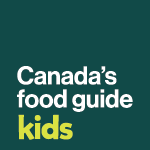Summary
Children will learn about different cooking methods recommended in Canada’s food guide. They will associate cooking methods to their corresponding description and image.
In a group they will then illustrate a snack and a meal using a large construction paper, grocery store flyers, and drawings. They will describe the cooking methods they would use to prepare the snack and meal.
Prep time
45 minutes
Activity duration
40 minutes
On this page
- Learning goals
- Materials
- Planning considerations
- Connecting to Canada’s food guide
- Activity instructions
- Optional learning extension
Learning goals
- Create different meals using Canada’s food guide.
- Recognize the benefits of using different cooking techniques.
- Describe cooking methods that could be used to prepare different meals.
Materials
- Glue
- Markers
- Scissors
- Crayons, pens or pencils
- Large construction papers
- Canada’s food guide snapshot
- Small construction or white papers
- Grocery store food flyers, print or digital
- Cooking methods activity sheet and answer key, one per child
Planning considerations
- Find grocery store flyers, in print or digital format.
- Consider how much time you would like your group to spend on this activity.
Connecting to Canada’s food guide
- Review the following pages for your activity planning:
Activity instructions
Engage
- Show children the Canada’s food guide snapshot. Explain that the food guide helps people in Canada eat a variety of nourishing foods each day.
- Ask:
- What groupings of foods do you see on the snapshot? Specifically:
- protein foods
- whole grain foods
- vegetables and fruits
- What are the different proportions of foods shown in the snapshot?
- specifically, vegetables and fruits occupy a larger proportion of the plate than protein foods and whole grain foods
- What else do you see on the snapshot? For example:
- Cook more often
- Enjoy your foods
- Eat meals with others
- Make water your drink of choice
- What groupings of foods do you see on the snapshot? Specifically:
- Explain to the children how the Canada’s food guide snapshot can be applied at each meal, including when preparing mixed dishes. It can also be applied to the combination of all snacks consumed throughout the day. Foods can be combined in different ways, such as in a bowl, plate, shared platter and more.
- Discuss the benefits and enjoyment of learning basic cooking, baking, and preparation skills.
- Ask:
- Have you helped cook at home?
- If so, what are some favourite foods to make?
- What are different cooking methods that you can name and what are they? For example:
- baking
- grilling
- broiling
- roasting
- steaming
- stir-frying
- Have you helped cook at home?
Tip: Consider having images of different cooking methods available to your group. These can help support children in naming and describing them.
- What are different ways you can help prepare a meal and prepare for mealtime? For example:
- set the table
- fill glasses of water
- turn off the television
- help to measure ingredients
- wash or peel vegetables and fruits
Tip: Review age-appropriate preparing tasks for mealtime.
- Some children may have varying levels of food skills and knowledge on cooking methods. Create a neutral environment where children can develop this knowledge without judgment.
Explore
Part 1 – Match the cooking method
- Explain to children that they will explore and become more familiar with different cooking techniques and terms through this activity.
- Provide each child with the Cooking methods activity sheet and a crayon, pen or pencil.
- Instruct children to draw a line connecting the name, description and image of cooking methods that go together.
Part 2 – Create a meal
- Divide children into groups of 2, and provide them with grocery store food flyers, small construction or white paper, and markers.
- Instruct them to write the following on 2 pieces of large construction paper:
- snack
- breakfast, lunch or dinner
- Ask children to create a meal and snack on their large construction paper. They can do this by gluing pictures from the flyers onto the paper. They can also draw foods that are not available in the flyers.
- Invite children to include foods from each food grouping, including vegetables and fruits, whole grain foods and protein foods in their meals and snacks. Use the snapshot as a starting reference for food and grouping ideas.
- Children can present their meals in any format they see fit. For example, they can present their meal on a plate, bowl, shared platter and more.
- Invite children to include foods that are part of their food traditions and culture. For example, rice is an important part of many cultures. Game meat may also have cultural importance to some of the children in your group.
- Ask children to reflect and prepare responses on the following:
- How would your family prepare this meal and snack?
- What steps would be used?
- Which cooking methods would be used?
- What steps could you help with?
- How could you help prepare the recipe?
- How could you help prepare for mealtime?
- How would your family prepare this meal and snack?
Explain
- Ask each group to present and describe their meal and snack. Ask children to explain which foods they have included.
- Ask each group to present:
- which cooking methods their family could use prepare their meals and snacks
- which steps they could help with to prepare the recipe and prepare for mealtime
- which steps would require adult supervision
Optional learning extension
Repurpose the Cooking methods activity sheet for a memory game.
- Cut out the cards containing the cooking method names and descriptions from the activity sheet.
- Shuffle the cards and place them face down on a flat surface.
- In groups of 2, ask children to take turns flipping 2 cards face up.
- If the name and description go together, the child can remove them from the game.
- The child can continue turning 2 cards at a time, until they do not obtain a match.
- If the name and the description do not match, the child must place the cards face down in their original location, and it becomes the next player’s turn.
- Children should try to remember the cards that had previously been turned face up to help them at their turn.
- Each group plays until there are no more cards left on the surface.



